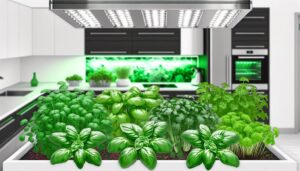Who Created the Kratky Method of Hydroponics
Dr. Bernard Kratky, a researcher at the University of Hawaii, developed the Kratky Method of Hydroponics.
He focused on creating a non-circulating, passive hydroponic system that simplifies soilless cultivation by eliminating complex equipment and pumps. This method relies on passive nutrient uptake, making it ideal for growing leafy greens and herbs.
Dr. Kratky's background in horticulture and his exposure to various plant growth systems inspired him to innovate a more sustainable and efficient farming technique.
By leveraging plant physiology and fluid dynamics principles, his method guarantees nutrient and oxygen access for peak plant growth. Curious about its wider impact?

Key Takeaways
- The Kratky Method of hydroponics was created by Dr. Bernard Kratky.
- Dr. Kratky is a researcher at the University of Hawaii.
- He developed a passive, non-circulating hydroponic system.
- The method eliminates the need for pumps and complex equipment.
Dr. Bernard Kratky

Dr. Bernard Kratky, a researcher at the University of Hawaii, revolutionized hydroponics with his eponymous non-circulating method, which simplifies soilless farming.
By eliminating the need for pumps and elaborate equipment, Kratky's method offers a low-maintenance, energy-efficient solution.
We've seen how it leverages passive nutrient uptake, where plant roots extend into a static nutrient solution. As the plants grow and consume nutrients, an air gap forms, providing necessary oxygen.
This method is particularly ideal for leafy greens and herbs.
Empirical studies show that the Kratky method can yield comparable results to more complex hydroponic systems without the associated costs and technical challenges.
Its simplicity and efficiency make it a viable option for both small-scale and commercial growers.
Early Career and Inspirations
Before pioneering his groundbreaking hydroponic method, Bernard Kratky commenced on a diverse and formative early career that shaped his innovative approaches in agricultural research.
He earned a Ph.D. in horticulture from the University of Hawaii, where he was immersed in cutting-edge agricultural studies. His work there exposed him to various plant growth systems and environmental control techniques.
We can see how his early career provided a robust foundation in understanding plant physiology and nutrient management.
Additionally, Kratky was inspired by the challenges of traditional soil-based agriculture, including water usage and soil degradation.
This combination of advanced academic training and real-world agricultural issues fueled his drive to explore more sustainable and efficient farming methods.
Development of the Method

Building on his extensive knowledge and experience, Bernard Kratky developed a hydroponic method that eliminates the need for pumps and complex irrigation systems, making it both cost-effective and straightforward for growers.
He focused on creating a passive system where plants can access nutrients and oxygen without mechanical assistance. By positioning plant roots to dangle into a nutrient solution, Kratky guaranteed they receive adequate nourishment.
As the plants grow, the water level decreases, exposing roots to air, thereby maintaining oxygen supply. This innovation reduces energy consumption and minimizes system failures.
Kratky's method democratizes hydroponics, making it accessible for both small-scale gardeners and large-scale farmers, thereby fostering sustainable agricultural practices.
Scientific Principles
The Kratky method leverages fundamental principles of plant physiology and fluid dynamics to enable efficient nutrient absorption and oxygenation.
By maintaining a static nutrient solution, we create a balance where plants' roots can access both water and oxygen without the need for pumps or aeration systems.
As plants consume water and nutrients, the fluid level drops, exposing a portion of the roots to air, which facilitates oxygen uptake.
This passive system relies on the natural growth patterns of roots, optimizing their access to essential resources.
It's an elegant solution that capitalizes on the plant's inherent capabilities, making it an innovative approach to hydroponic cultivation.
We see this as a demonstration of how understanding basic scientific principles can drive practical, sustainable agricultural methods.
Impact on Hydroponics

We observe that the Kratky method's impact on hydroponics is profound, as it simplifies the cultivation process while maximizing resource efficiency and sustainability. By eliminating the need for pumps and continuous water circulation, the Kratky method reduces both initial setup costs and ongoing energy consumption.
Consider these key advancements:
- Resource Efficiency: The passive nature of the Kratky method means less water and nutrient solution is wasted, aligning with sustainable practices.
- Accessibility: Its simplicity makes hydroponics more accessible to beginners and those with limited resources, broadening the user base.
- Scalability: The method can be easily scaled from small household setups to larger commercial operations, providing flexibility to various growers.
These factors collectively demonstrate the method's transformative potential in modern hydroponics.
Conclusion
We've seen how Dr. Bernard Kratky revolutionized hydroponics with his innovative method. By eliminating the need for constant water flow, he made growing plants simpler and more accessible.
For instance, a small urban farm in New York successfully used the Kratky method to grow fresh herbs year-round, demonstrating its practical application.
This method's impact is undeniable, offering a sustainable solution that can be adopted globally to address food security challenges.






